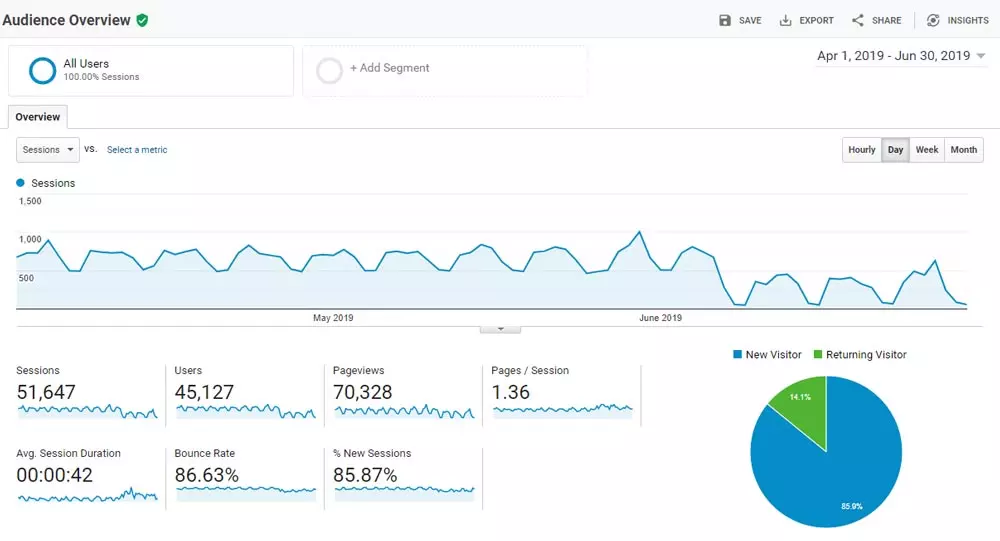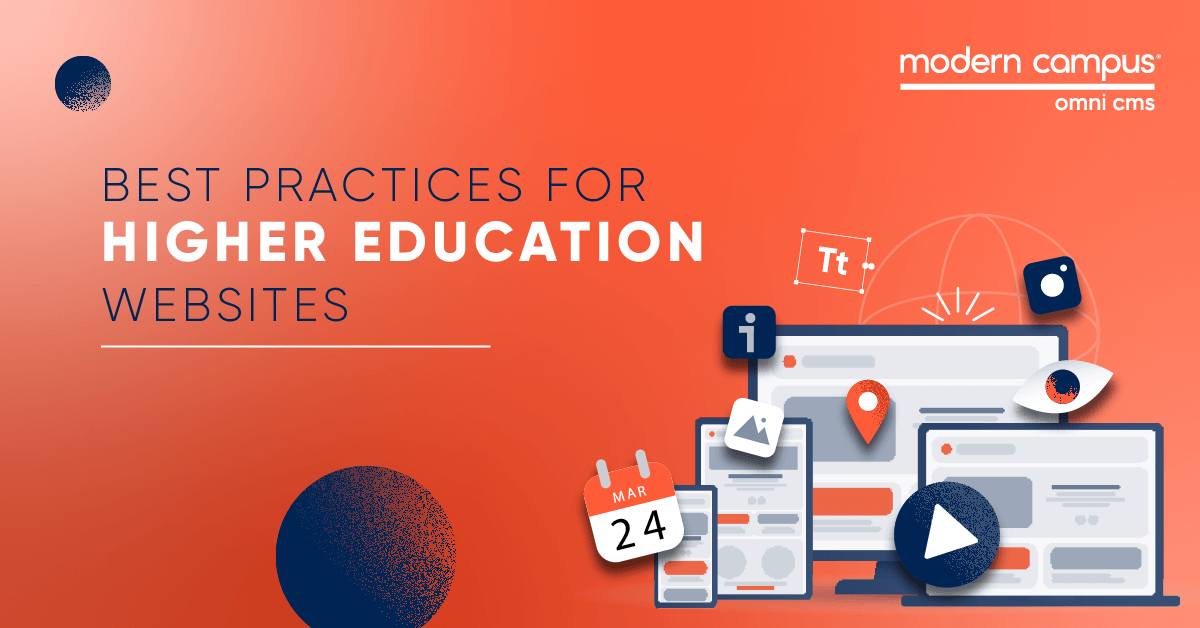10 Best Practices for Higher Education Websites
Higher education has seen more changes than ever in the past couple of years. The collegiate experience for students has been permanently altered by virtual classes, reduced in-person interactions and other pandemic-related demands.
Higher education websites have proven to be essential for digitally engaging students during this difficult period. For example, virtual tours allowed prospective students to learn more about campus life even if they could not visit the campus for an in-person tour; the blog posts on your website allowed your alumni to stay informed, and your online giving options allowed your benefactors to continue supporting you.
Both your digital marketing and your web management must stay up to date with modern trends as prospective students are growing more and more tech aware. Otherwise, competing institutions might surpass yours in online visibility.
That is why overseeing a content calendar, staying GDPR- and accessibility-compliant, optimizing your website for search, and keeping content current are crucial website management services and practices for maintaining a strong online presence.
Implement these higher education website best practices for high-quality management:
- Prioritize accessibility.
- Make courses easy to find
- Embrace inclusive website design
- Invest in good content
- Update content frequently.
- Make real-time updates
- Monitor website performance.
- Double down on privacy.
- Choose a powerful content management system (CMS).
- Create a website governance policy.
Your school website is the front door to your institution—especially to prospective students who do not live close by. When you give prioritize consistent, ongoing website management, you’ll ensure the accuracy, accessibility, and freshness of your institution’s digital presence.
What’s the big deal about content? Download our white paper Manage Website Content Like a Pro: 8 Steps to Success to learn more about optimizing content for search, creating an editorial calendar, developing a content strategy, and measuring your website’s success.
1. Prioritize accessibility
Accessibility. Accessibility. Accessibility. You’re probably tired of hearing how important it is to manage your website in a way that is accessible to everyone, but this issue is not going away. If anything, web accessibility will become an even bigger priority as Universal Design Learning (UDL) practices become more prevalent.
UDL guidelines provide a framework for design and composition of content based on scientific insights into how humans learn. UDL practices apply both on and offline so that all learners, including those with accessibility challenges, can access and participate in learning opportunities.
Stay ahead of the game by incorporating accessibility concerns into your website management protocol. This best practice is one way to ensure compliance and avoid receiving a dreaded OCR letter.

61 million adults in the United States live with a disability.
Infographic courtesy of the Centers for Disease Control and Prevention
2. Make courses easy to find
Prospective students frequently begin with a simple web search, such as "best colleges for business" or "best university for computer science." They may be curious and have a rough goal in mind but not a specific school. They presumably seek details on fields of study, admission requirements, experiments or campus life once they reach your website.
Searching for courses is a primary need for prevailing or genuine prospective students. Therefore, higher ed websites search must be simple, swift, and offer a good user experience to quickly find what they are looking for. A thorough and efficient search function will provide query suggestions as users type. Keep in mind that outcomes should be rooted in significance and consider searchers' typos.
3. Embrace inclusive visuals
Websites for higher education have begun to rely heavily on strong visuals that reflect a diverse range of students. These images are genuine, depicting interactions between students and campus life opportunities.
Genuine, authentic, candid and truthful website visuals are the most appealing to today’s learners. Also, ensure that the images on your website fairly reflect your diverse school community. Prospective students will feel more at ease applying to your college if they recognize themselves displayed and reflected on your website.
4. Invest in good content
Creating meaningful content is a must for higher education institutions. A higher education website must be attractive, informative and engaging.
You want to include as much diverse and rich content as possible. Create interactive virtual campus tours, embed photo galleries of your greatest accomplishments and blog about major events. Share graduate success stories and gather testimonials from alumni.
5. Update content frequently
Outdated content is not a big deal if you constantly add new content to your website, right? Wrong! Dumping new content onto your website without revising existing content and deleting outdated content creates bloat—which becomes a big headache when you decide it’s time for a website redesign.
It also reduces site optimization because outdated, duplicated, and unmanaged content contributes to a confusing navigation structure and is likely to have broken links and old keyword optimization.
Above all, outdated content on your website includes old dates and information. Imagine if a prospective student lands on outdated admissions landing pages and submits an application after the deadline. Or what if a donor wants to make a donation but can’t find a current address? The last thing you want to do is mislead your audience and worse, give the impression that your college or university doesn't care about keeping its website readers up to date.
6. Make real-time updates
University and college websites are incorporating sources of recurring upgrades on everything, from breaking news to research advances.
Elements like social media feeds, blog post updates and news articles make higher education websites look fresh and relevant. They demonstrate to visitors that the university is up to date on current events.
By featuring news and current events on your higher education website, you can make it a useful resource for not only your university's community, but also a larger audience of former students, faculty members, donors, researchers and prospective students who want to stay up to date with your institution.
7. Monitor Website Performance
College and university website maintenance is an ongoing task to ensure that broken links, orphaned pages, unlinked videos and resources, and other elements on your website are accurate and working. Performing these tasks manually is time-consuming, so invest in a content management system that automates these tasks for you.
You’ll also want to implement a way to measure your website’s performance. Install Google Analytics to better understand the science behind your website and how you can better engage and attract prospective students to your college or university.
 Your institution can better understand the science behind your website through Google
Analytics when you know how to use its tools.
Your institution can better understand the science behind your website through Google
Analytics when you know how to use its tools.
8. Double-Down on Privacy
The European Union’s General Data Protection Regulation (GDPR) has schools on hyper-alert regarding privacy issues. The rule protects the personal data of all people who live in the EU, even if they are not citizens of the foreign country where they reside—and even if they are not physically living in the EU. This means that if you have any foreign students attending or a foreign faculty member teaching at your school, their data is protected by GDPR laws. The same goes for your U.S. students who study abroad in an EU country.
Complying with GDPR protects your school, but also boosts your website management practices in regard to pending U.S. privacy laws as many states are now implementing laws similar to GDPR.
9. Choose a Powerful Content Management System (CMS)
A powerful CMS allows you to publish content for your website as well as manage a host of other college and university website maintenance duties, including:
- Workflow management. Multi-stage workflows are built into a good CMS with user levels for reviews and approvals so that there is no lag in publishing information when it is most needed.
- Global site changes and updates. If you aren’t using a robust CMS, you’ll have to make both major and nuanced changes on every single page of your website. A quality CMS allows you to make these changes once and then apply them to all pages globally throughout your website, instantly. The same applies to legal changes, emergency alerts, and other critical messaging.
- Automatic security updates. Most commercial CMS products feature automatic security updates, eliminating the need for you to monitor patches and new updates and then manually load them. Likewise, with a quality CMS, your website will be supported for the life of the CMS.
Shopping for a CMS? Schedule a demo of Modern Campus CMS, the most powerful CMS for higher ed.
10. Create a Website Governance Policy
Outlining your web governance strategy in writing and with input from vested parties ensures that everyone who works on your site is aligned with your college or university website strategy and expectations. A website governance policy details your institution’s structure of people, processes, and policies to maintain and manage your website. Get buy-in from senior administration to aid with enforcement and understand that a website manager can oversee, at best, around 200 pages.
Finally, make sure that your website governance policy is easily accessible (many schools include their governance policy on their website) so that when questions arise, they can be resolved with a quick review.
College website management doesn't have to be a chore. For the best long-term results, take the time to think through the process, implement best practices, identify stakeholders who can offer valuable input, and develop a comprehensive web governance policy for your school.
Is a website redesign in your future? Learn everything you need to know by downloading our whitepaper College and University Website Redesign: The Ultimate Guide
Download the ultimate guide now
Last updated: June 5, 2023




